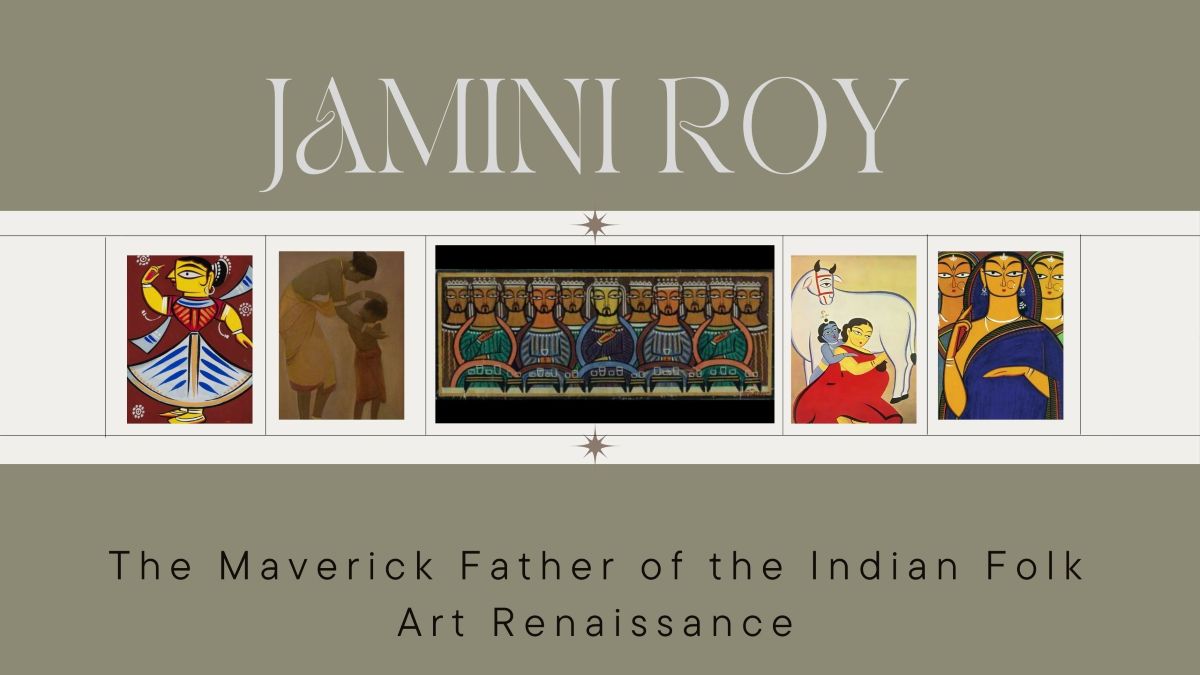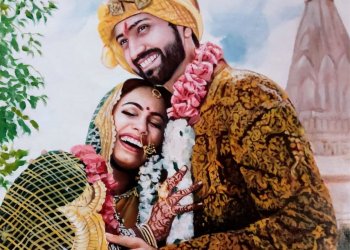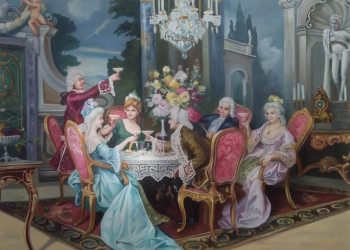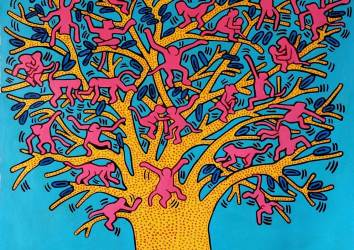Meet Jamini Roy, the artist who brought Bengal’s folk traditions to the forefront of modern Indian art. A journey through his life and legacy. Tracing his birth, education, art style, famous paintings, and his pivotal role in reviving Indian folk traditions.
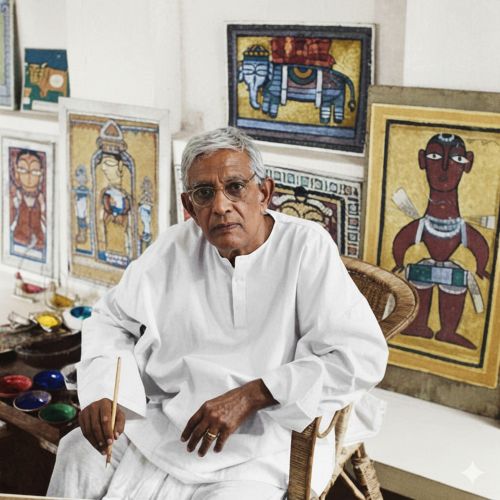 Artist Jamini Roy in His Studio
Artist Jamini Roy in His Studio
Jamini Roy (1887-1972), born in 1887, stands as a towering figure in the modern Indian art landscape. This pioneer boldly charted a course away from the dominant Western artistic influences of his time. His artistic journey, marked by a radical shift in style and ideology, led him to create a unique visual language that resonated deeply with the cultural ethos of India, particularly Bengal.
Even today, his works continue to inspire artists and provoke critical discourse on the notions of tradition, identity, and authenticity within the art world.
Jamini Roy: Early life and background
Born in the culturally rich village of Beliatore in the Bankura district of West Bengal, Jamini Roy hailed from a moderately prosperous Kayastha family of landowners. His upbringing in a middle-class household that appreciated the arts significantly shaped his future artistic inclinations. The region of Beliatore itself, known for its vibrant terracotta crafts and folk painting traditions, likely provided an early and formative visual environment for the young Roy.
Education and training
At sixteen, Roy embarked on a formal artistic education at the Government College of Art in Kolkata, then the epicenter of artistic learning in India. There, he had the opportunity to study under Abanindranath Tagore, a key figure in the nationalist art movement and the founder of the Bengal School, who served as the institution's vice-principal. Roy's academic training was grounded in the prevailing Western tradition, where he learned the techniques of drawing classical nudes and painting with oils on canvas, skills that would later inform, and then be deliberately set aside, in his artistic evolution. Upon completing his Diploma in Fine Art in 1908, Roy initially established himself as a commissioned portrait painter, creating oil portraits and memorial portraits from images and photographs (like Paintphotographs.com). His realistic oil portraits quickly earned him a reputation within the Calcutta art circles, showcasing his technical mastery of the Western academic style. These early works demonstrated his ability to absorb and express himself through the prevailing international artistic idioms.
In 1916, Jamini Roy married Amiyasundari Devi. The couple had four sons and a daughter.
But, despite the early success and the financial stability it offered, Jamini Roy harbored a growing sense of dissatisfaction. An internal conflict within him spurred him to seek a more authentic artistic expression, one that was deeply rooted in his own cultural identity.
It was during this time that he received an art commission from brothers Abanindranath Tagore and Gagendranath Tagore to create a portrait painting of Debendranath Tagore, father of Rabindranath Tagore. The commission brought him into contact with Sunayani Devi, the sister of Abanindranath Tagore, whose art was deeply rooted in folk traditions. Her distinctive approach, grounded in the cultural richness of folk heritage, resonated with his own desire to create a more authentic and individual style.
Order Your Portrait Painting from Photo today!
Jamini Roy’s Quest for his authentic art style
The early 1920s marked a pivotal moment in Jamini Roy's artistic journey as he made the radical decision to abandon his established career as a portrait painter in pursuit of a unique artistic voice.
As Partha Mitter writes in The Triumph of Modernism, Jamini Roy was convinced that the ‘revival of Bengali art will not come from Ajanta, Rajput and Mughal art . . . [for] one may learn a language that is not one’s own but one cannot enter its inner thoughts’. This stand went against the prevailing philosophy of the Bengal School of Art led by Abanindranath Tagore, which held that the future of Indian art was in the revival of the past. It was under Abanindranath Tagore that he enrolled in 1906 at the Government Art School in Calcutta (now Kolkata). While he shared the Bengal School’s concern with artistic authenticity, the ‘historicism’ of the Bengal School left him cold.
His period of searching led him to his first significant experimentation between 1921 and 1924. Initially, he learned from Kalighat paintings and mimicked their style, but he soon rejected them, convinced that the Kalighat painters had lost their folk ideals in the service of their urban patrons. He traveled deep into rural Bengal to find authentic folk artisans, discovering the source of inspiration in the vibrant movements of the Santhal dance and the Santhal community. By the 1930s, this shift towards indigenous artistic expression culminated in his complete adoption of local materials for his paintings, signifying a profound commitment to an authentically Indian artistic practice. A key aspect of this transformation was his deep fascination with the Kalighat Pat, a distinctive Bengali folk art style known for its bold, sweeping brush strokes. Roy recognized the inherent power of this folk tradition as a means to connect with the lives of ordinary people and to reclaim the splendor of Indian art from colonial influences.
As Mitter notes, ’While Roy acknowledged his debt to the naïve painter Sunayani Devi, he achieved his radical simplifications through a slow, deliberate, and systematic process.’
Jamini Roy’s Art Style
Jamini Roy developed a painting style that fused his European academic training with the vitality of Bengali folk traditions. Characterized by bold, sweeping lines, flat areas of vibrant color, and simplified forms, his work drew inspiration from Kalighat patachitra, Santhal tribal art, religious iconography, and scenes of rural Bengali life. Western critics often described this approach as Primitivism, but for Roy, it was a conscious effort to reclaim indigenous visual language. In other words, he created his own Pirmitivist style.
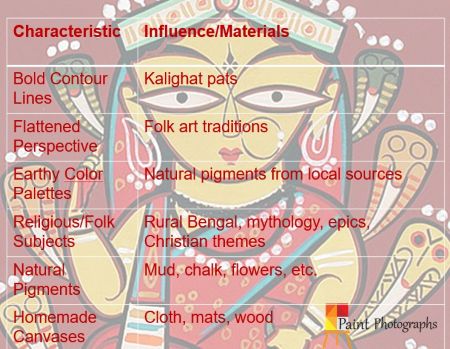 Jamini Roy Painting Style Characteristics Infographic (image source: Paintphotographs.com)
Jamini Roy Painting Style Characteristics Infographic (image source: Paintphotographs.com)
To recover the purity of the ‘Pat’ tradition, he began with austere monochrome brush drawings before moving to a palette of seven basic tempera colors: Indian red, yellow ochre, cadmium green, vermilion, charcoal grey, cobalt blue, and white. Like the traditional rural artists, he prepared these colors from natural materials like rock dust, tamarind seeds, mercury powder, alluvial mud, indigo, and chalk. He used lamp black for outlines and replaced imported oils with handmade tempera on home-spun cloth, which he fashioned into his own canvases. In this way, Roy created an art that was both modern in its innovation and deeply rooted in indigenous practice. His radical turn to indigenous art also influenced Amria Sher-Gil, according to art expert Maie Casey, wife of the last Lieutenant Governor of Bengal and a devoted patron of Roy's work, ‘if not directly by his art then by his philosophy, which drew its strength from life and not from the past’.
Influence of Adivasi Santhals & Kalighat Pats on Jamini Roy
He became an avid collector of these Kalighat pats, deeply appreciating their simplicity, vigorous and spontaneous lines, forms, and bold colors, elements that would significantly inform his evolving style. Simultaneously, Roy was drawn to the art of the Santhal tribe, an indigenous community in the Bengal region. His early explorations with the Santhal dance depicted their community life with a sense of quiet dignity. He sought to understand and integrate the essential qualities of native folk painting, blending the minimalist brushstrokes of the Kalighat style with distinct elements of tribal art from Bengal. Roy's artistic vision was nourished by the rich tapestry of Bengal's folk narratives, drawing inspiration from the terracotta and wooden toys crafted in village haats, the intricate friezes adorning the terracotta temples of Bishnupur, and the vibrant scroll paintings created by folk artists. His canvases began to depict scenes from the everyday lives of villagers, as well as popular Bengali myths and folklore, reflecting a profound connection to his cultural roots and the stories of his land. This radical shift in Jamini Roy's artistic path was deeply intertwined with the broader Swadeshi and nationalist cultural renaissance that was sweeping through India in the early 20th century.
Handmade Art Reproductions & Landscape Paintings
Roy's Rebellion Against the Western Academic Style
His rebellion against the Western academic style, in which he was initially trained, coincided with a rising tide of nationalism in Bengal, fueled by a desire to break free from British colonial rule. Roy consciously turned away from Western customs, seeking inspiration and artistic truth within his own cultural heritage. His emphasis on the local and rural in his artistic choices was not merely aesthetic but also an overtly political act, a form of resistance against the pervasive influence of colonial rule. Inspired by Mahatma Gandhi's Non-Cooperation Movement, which urged the nation to embrace 'Desi' (indigenous) products, Roy's artistic transformation reflected a deep commitment to self-reliance and the celebration of Indian identity.
Jamini Roy's artistic journey culminated in the development of a highly distinctive, recognizable signature style. His idiom was characterized by a highly simplified and flattened-out two-dimensional aesthetic, reminiscent of European modern art in its abstraction but rooted in the visual traditions of Bengali folk art.
Roy embraced a linear, decorative, and colorful art style that deliberately rejected the European academic emphasis on formalism and realism. His artistic approach was an eclectic blend of his initial Western training and his deep engagement with Indian inspiration. A defining feature of Roy's style was his use of bold contour lines, directly inspired by the sweeping brush strokes of Kalighat pats. These lines, described as carefully drawn and deliberately realized, served to define the essential forms of his subjects with clarity and precision. In contrast to the Western emphasis on depth, Roy adopted a flattened perspective, a hallmark of many Indian folk art traditions. He intentionally discarded nonessential background details, creating a two-dimensional picture plane that focused attention squarely on the main figures. Roy's color palettes were also distinctive, typically featuring a restricted range of seven vibrant yet earthy colors, including Indian red, yellow ochre, and cadmium green, all derived from natural sources. His subject matter was equally significant, predominantly featuring religious and folk themes that resonated with the cultural landscape of Bengal. He depicted scenes from village life, the Santhal community engaged in their daily activities, and the rich narratives of Hindu epics and mythology, including the Ramayana, Mahabharata, and Krishna Leela. Interestingly, Roy also explored Biblical themes, particularly the life of Jesus Christ, adapting these narratives into a distinctly Indian visual context. He further distanced himself from Western conventions by painting on unconventional surfaces such as cloth, mats, and wood treated with lime, aligning his practice with traditional Bengali art forms. His preference for being called a patua, a traditional scroll painter, underscored his deep connection to the folk traditions that inspired his artistic vision.
Jamini Roy Artworks & Five Famous Paintings
Jamini Roy's oeuvre is rooted in his intimate observations of rural existence, marked by thematic depth, and his extensive engagement with Hindu iconography and Christian mythology.
Roy's artistic genius is best understood through an examination of his seminal works. Presented here are five of Jamini Roy’s most notable and famous works. Selected from diverse periods of his life.
His Mother and Child series, characterized by bold lines and earthy colors, explored the universal theme of maternal love. His Ramayana series, a monumental work spanning 17 canvases, narrates the epic tale using the Kalighat pat style and natural pigments.
Dancing Girl by Jamini Roy
The central figure, a dancing girl, dominates the composition. Her form is highly stylized, almost geometric, yet imbued with a dynamic energy that suggests movement. The face, rendered in a striking yellow, features an elongated eye that is both expressive and iconic, a hallmark of Roy's figures. The profile view, with its sharp nose and prominent chin, further emphasizes the graphic quality of the painting.
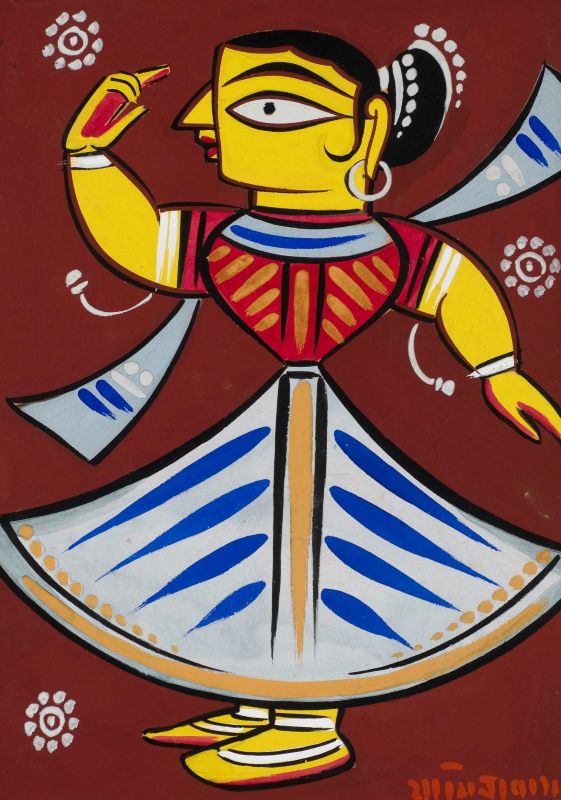 Untitled (Dancing Girl) Painting by Jamini Roy (image source: Wikimedia Commons)
Untitled (Dancing Girl) Painting by Jamini Roy (image source: Wikimedia Commons)
Title: Untitled (Dancing Girl)
Creator: Jamini Roy
Type: Tempera on card
Physical Dimensions: 16 x 10 3/4 in (40.5 x 27.3 cm)
The dancer's attire is rendered in a limited but impactful palette. Her upper body, a vibrant yellow, is adorned with red and blue accents. While her skirt flows in a graceful, fan-like shape, predominantly white with strong blue strokes. That mimics folds and movement. The interplay of these primary and secondary colors, yellow, red, blue, and white, creates a powerful visual rhythm. The background, a deep, earthy red, provides a stark contrast, allowing the figure to pop out with intensity. Scattered floral motifs in white further enrich the surface.
Roy's brushwork is confident and unhesitating, outlining the forms with thick, dark lines that define the contours and add to the graphic strength of the piece. This emphasis on outline and flat areas of color eliminates the need for illusionistic depth, drawing the viewer's attention to the surface and the inherent beauty of the forms themselves.
Mother and Child by Jamini Roy
One of his early works, before he fully developed his signature style, ‘The Mother and Child’ by Jamini Roy, presents a poignant moment. This painting offers a more subdued palette and a softer, more introspective mood, highlighting Roy's versatility and his profound engagement with universal human themes.
The composition features two figures, a mother and a child, rendered in a warm, muted earthly color scheme. The mother, clad in a simple yellow sari, stands with a gentle curvature to her body, her hands delicately comforting the child. Her form is supple and graceful. Her dark hair is pulled back, and subtle jewelry adorns her wrists and ankles, adding understated elegance to her presence.
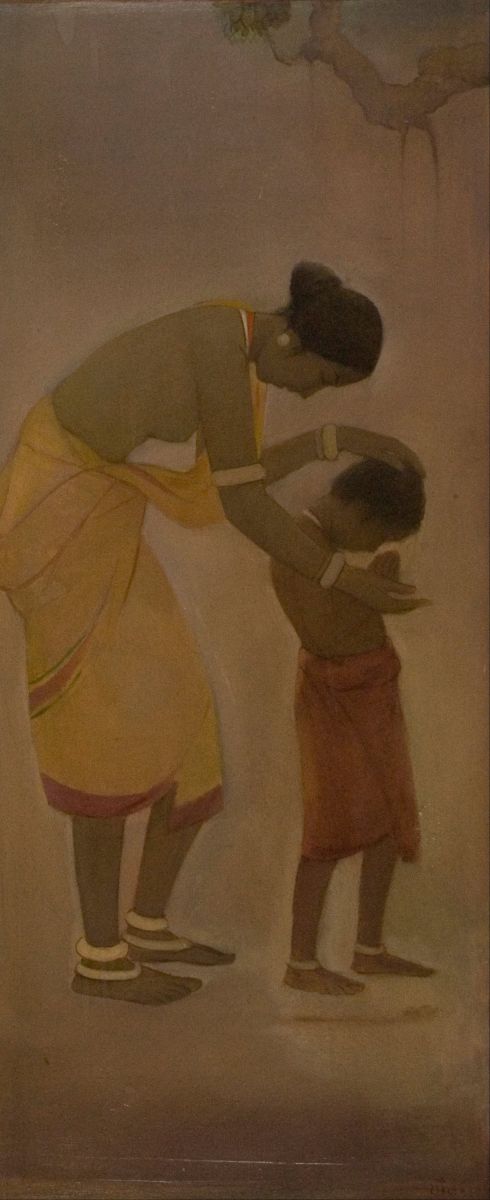 Mother and Child painting by Jamini Roy (image source: Wikimedia Commons)
Mother and Child painting by Jamini Roy (image source: Wikimedia Commons)
Title: Mother and Child
Creator: Jamini Roy
Physical Dimensions: 465 cm x 1165 cm
Type: Oil on canvas
The child, standing slightly bowed before the mother, appears to be receiving comfort. The child's posture is contrite and trusting. Clad in a red lower garment that contrasts subtly with the mother's yellow. The interaction between the two is central to the painting, conveyed through their proximity with the tender gesture of the mother's hands on the child's head. The gesture speaks volumes of maternal affection and the protective bond of Mother and Child.
The background is minimalist. A soft, ethereal blend of browns and earthly tones that emphasizes the figures and their connection. The choice of palette imbues the scene with a quiet love and tenderness that only a mother can feel for her child. A hint of foliage or a tree branch can be seen at the top, suggesting an outdoor setting. Yet the overall focus remains on the human interaction. The brushwork is smoother, more blended, contributing to the soft-focus quality.
Unlike the vibrant, almost stark contrasts in his "Dancing Girl," this painting employs a more monochromatic hue to create harmony. Relying on subtle shifts in tone and color to create depth and mood.
Three Pujarins by Jamini Roy
Three Pujarins by Jamini Roy is a quintessential example of the artist's mature style. Embodying his profound connection to Bengali folk art traditions while simultaneously asserting a modernist aesthetic. The painting is a powerful composition, characterized by its striking simplicity, vibrant color palette, and iconic representation of figures.
The artwork features three female figures, identified as ‘Pujarins’ or priestesses, arranged in a vertically oriented composition. The central figure is the most prominent, depicted frontally, with the other two partially visible behind her, creating a sense of depth and community. Roy's signature stylization is immediately apparent in their faces: elongated, almond-shaped eyes with heavy lids, prominent arched eyebrows, and small, delicate lips. Each face is rendered in a warm, uniform ochre or yellow tone, a common feature in Roy's depictions of the human form, lending a radiant quality to their countenances.
 Three Pujarins Painting by Jamini Roy (image source: Wikimedia Commons)
Three Pujarins Painting by Jamini Roy (image source: Wikimedia Commons)
Title: Three Pujarins
Creator: Jamini Roy
Physical Dimensions: 16 x 30 in (40.64 cm x 76.20 cm)
Type: Tempera on paper
The Pujarins are adorned with traditional Indian jewelry, including nose rings, earrings, and necklaces, depicted with minimalistic yet effective lines and dots that suggest intricate metalwork. The central figure is draped in a rich, deep blue sari, its folds suggested by broad, flat planes of color and subtle outlining. The vibrant blue creates a powerful contrast with the warm skin tones and the hints of red and green from the other figures' attire in the background. Her hands are elegantly posed, with one finger raised, possibly indicating instruction, contemplation, or a ritualistic gesture, adding a narrative dimension to the otherwise still figures.
The background is sparse. Allowing the figures to dominate. The colors used for the background figures, mainly green and red, are rendered in flat tones. Emphasizing the two-dimensional flatness and graphic quality that Roy adopted. The overall composition is harmonious, with a strong sense of balance and rhythm. Created by the repetition of facial features and the interplay of primary and secondary colors.
Roy's brushwork is bold and confident. The thick, dark outlines reminiscent of traditional scroll paintings or patachitra to define the forms. The approach eliminates superfluous detail, focusing only on the essential characteristics of his subjects.
‘Three Pujarins’ is a celebration of Indian womanhood, tradition, and the spiritual essence that Jamini Roy sought to capture. Through this painting, Roy reasserts the power of indigenous artistic forms. Distilling them into a visual language that is deeply rooted in his heritage and strikingly contemporary. It stands as a testament to his unique contribution to modern Indian art, where simplicity of form and purity of color converge to create timeless iconic imagery.
Krishna Yashoda by Jamini Roy
Krishna Yashoda by Jamini Roy is a tender and iconic portrayal of a beloved motif in Indian iconography, rendered with the Jamini Roy's distinctive style that blends folk aesthetics with modernist sensibilities. The painting encapsulates the intimate relationship between the child Krishna and his foster mother Yashoda. A theme often celebrated in Indian art for its depiction of unconditional maternal love and divine playfulness.
The composition centers around two human figures: Yashoda in the foreground and the young Krishna nestled behind her, along with a prominent white cow. Yashoda is depicted milching the cow in a traditional red sari, her form robust and maternal. Her face, typical of Roy's painting, features almond-shaped eyes, a strong brow, and full lips, rendered in a warm, earthy yellow hue that signifies vitality and inner glow. Her posture suggests an act of milking or tending to the cow. Grounding the divine narrative in the everyday pastoral life of Vrindavan.
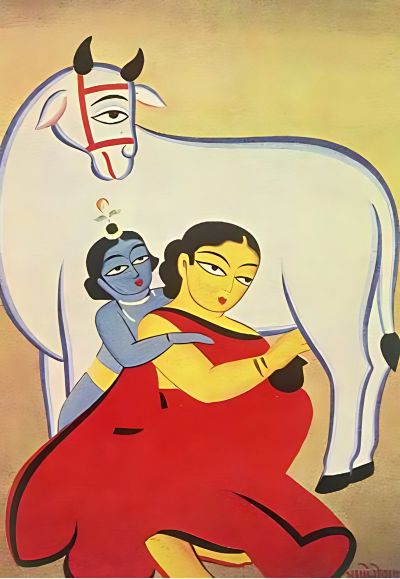 Krishna Yashoda painting by Jamini Roy (image source: Wikimedia Commons)
Krishna Yashoda painting by Jamini Roy (image source: Wikimedia Commons)
Title: Krishna Jasoda
Creator: Jamini Roy
Physical Dimensions: 16 x 30 in (55 cm x 76cm)
Type: Tempera on board
Behind Yashoda, peeking over her shoulder and clinging to her, is the figure of Krishna. His skin is rendered in a distinctive blue, a traditional color for the deity. Though a child, his features possess a serene and mischievous quality, with the same stylized eyes as his mother, topped with a small, delicate peacock feather, signaling his divine status. His gesture of embracing Yashoda from behind speaks volumes about his love for his mother, even as a God.
Dominating the upper half of the canvas is a large, white cow, its form simplified yet powerfully drawn. The cow, a sacred animal in Hinduism and a constant companion in Krishna's childhood, stands as a symbol of benevolence. The single large eye mirroring the stylized eyes of the human figures. Its white body, outlined with sweeping lines and accented with red on its harness and black hooves, provides a powerful visual contrast to the vibrant colors of Yashoda and Krishna. The background is a soft, ochre wash, which allows the figures to emerge with clarity and warmth.
Roy's brushwork is bold and deliberate. Using strong outlines to define the forms and flat areas of color to create a sense of depth and volume. The painting style draws heavily from Kalighat Pat painting and other Bengali folk art traditions, which Roy rigorously studied. The painting's strength lies in its ability to convey profound emotion and spiritual narrative through elemental forms and a restricted palette.
Krishna Yashoda is more than a religious or devotional painting. It is a celebration of the universal sacred bond of love between a mother and child. And the divinity of everyday life.
The Last Supper By Jamini Roy
The Last Supper by Jamini Roy is a fascinating and important work. Marking a distinct phase in the artist's prolific career, when he was deeply engaged with Christian iconography, seen through his unique modernist folk-art-inspired lens. The painting was created during a period when Roy was notably influenced by Byzantine art and Christian narrative.
The composition is painted in a horizontal tableau, characteristic of traditional depictions of the Last Supper, but rendered with Roy's signature style. There are eleven figures depicted seated around a table in a flattened two-dimensional approach. The central figure, presumably Jesus Christ, is distinguished by his lighter, luminous, yellow-hued face, contrasting with the earthier tones of the apostles. He wears a dark blue garment.
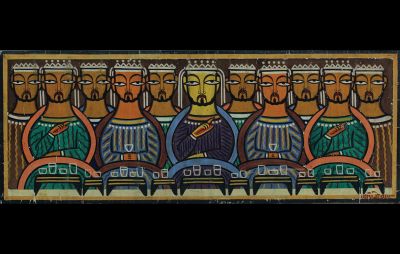 Last Supper Painting by Jamini Roy (image source: Wikimedia Commons)
Last Supper Painting by Jamini Roy (image source: Wikimedia Commons)
Title: The Last Supper
Creator: Jamini Roy
Physical Dimensions: 37 in x 18 in (95.5 cm x 48 cm)
Type: Tempera on cloth pasted on cardboard
All the figures share Roy's iconic facial features: large, piercing, almond-shaped eyes that dominate their expressions, prominent noses, and stylized beards and mustaches. Each figure is depicted with a crown reminiscent of Byzantine frescoes. Their bodies are depicted in simplified, sweeping lines, with distinct, often striped garments in green, orange, and earthly hues, creating a rhythmic pattern across the canvas.
On the table before them are abstract shapes representing dishes, glasses, and cups. The background is a solid, dark brown, which serves to highlight the figures and their vibrant attire, drawing the viewer's eye directly to the dramatic gathering. The thick, dark outlines, a hallmark of Roy's style, are used to define each figure and object with precision. This gives the composition an almost stained-glass window effect.
The Last Supper is a remarkable synthesis of Eastern and Western artistic traditions. Roy strips away the illusionistic realism often found in Western Renaissance depictions, opting instead for an elemental and symbolic representation. This painting is a reinterpretation that speaks to universal themes of faith, sacrifice, and communion.
Once, Maie Casey, wife of the last Lieutenant Governor of Bengal and a devoted patron of Roy's work, wanted to know why Roy, an orthodox Hindu, should be moved by Christianity. Jamini Roy replied, ‘he wanted to attempt a subject remote from his own life and to show that the human and the divine could be combined only through symbols’. Roy's adoption of a Christian theme, combined with his folk-art aesthetic and the visual language of Byzantine art, creates a fresh take and profound reinterpretation of the famed biblical story of the Last Supper.
Roy's Quiet Nationalism
Jamini Roy's artistic endeavors were informed by his ideological commitment to Swadeshi values. His rejection of Western academic styles and materials was a powerful act of resistance against colonial cultural dominance, aligning his work with the burgeoning nationalist sentiment in India. Inspired by Mahatma Gandhi's call for indigenous products, Roy consciously chose to use local materials and techniques. Roy held strong anti-elitist views on art, believing it should be accessible to all, particularly the ordinary middle class, whom he saw as the true patrons of his work. He deliberately kept the prices of his paintings affordable, sometimes even gifting them away, to ensure that art was within reach of a wider audience. Roy redefined the role of the artist in a decolonizing nation by identifying himself as a patua, a folk scroll painter. He challenged the established elitist gallery system by often selling his work directly from his studio.
Jamini Roy: Exhibition & Recognitions
Despite his radical departure from mainstream art practices, Jamini Roy garnered significant recognition during his lifetime.
In 1929, Jamini Roy presented his first experiments with folk art at an exhibition organized by Alfred Henry Watson, the English editor of The Statesman. The following year, on 9 July 1930, he exhibited at the Indian Society of Oriental Art, marking his decisive shift from a tentative orientalist approach to a bold primitivist style. By 1931, Roy was confident enough to articulate his artistic ideology publicly, holding an exhibition at his modest North Calcutta residence, inaugurated by the noted art historian Stella Kramrisch.
 Artist Jamini Roy Life Infographic (image source: Paintphotographs.com)
Artist Jamini Roy Life Infographic (image source: Paintphotographs.com)
His originality soon began to attract wider recognition. In 1935, he received the highest accolade at the Academy of Fine Arts in Calcutta for his celebrated work, Santhal and Child. That same year, K. C. Das, a leading confectioner of the city, commissioned him to create a monumental series of seventeen paintings based on the Ramayana. Each measuring 35.8 inches x 155.9 inches (91cm x 396 cm), for his reception room, a project completed in 1940.
Roy’s stature as a modern Indian artist continued to grow. In 1937, a major retrospective at the Indian Society of Oriental Art, inaugurated by Bengal’s Prime Minister, A. K. Fazlul Huq (the title of Chief Minister was not yet established), firmly established his reputation. The noted art critic Shahid Suhrawardy hailed the exhibition as an event of “first-rate importance” in the history of modern Indian art. Through the 1940s, his reputation only grew. He had his exhibitions in 1941 and 1944, receiving critical acclaim. Both the Bengali middle class and the European community became avid collectors of his art. Thus cementing his place as one of the most distinctive voices in Indian modernism.
This period also saw his work going international with exposure through exhibitions in London in 1946 and in New York in 1953. The Government of India honored his contributions to art by awarding him the Padma Bhushan in 1954. In 1956, he was elected as a Fellow of the Lalit Kala Akademi, the highest honor in the fine arts conferred by India's National Academy of Art.
In the same year, 1956, the Asian Artists in Crystal exhibition opened at the National Gallery of Art in Washington, D.C. The remarkable exhibition showcased a unique collection of 36 glass objects designed by 36 artists chosen from 16 countries, which were then engraved onto Steuben crystal.
The catalogue to the exhibition described Jamini Roy as an internationally recognized master and a modest, retiring “medieval” craftsman in private life. The following year, the Smithsonian Institution Travelling Exhibition Service featured his work at venues including the Columbus Museum of Arts and Crafts in Ohio. He was also selected to design UNICEF Christmas cards. In 1971, his paintings, curated by Roy Craven, were exhibited at the University of Florida Art Gallery, where they received popular acclaim.
Jamini Roy passed on April 24, 1972, at the venerable age of eighty-five. In his final days, Roy battled uraemia and slipped into a coma a day before his peaceful demise at his South Calcutta residence.
Jamini Roy is now firmly situated within the firmament of Indian art as one of the first and most important modernist artists. His works have been declared national art treasures. His enduring influence on subsequent generations of Indian artists is undeniable, inspiring them to explore their own cultural roots and develop unique artistic languages. Roy's pioneering work also played a crucial role in the folk art revival in India, bringing traditional techniques and aesthetics into the mainstream of modern artistic expression.
By bringing the living traditions of Bengal to the forefront of his artistic practice, Roy validated indigenous art forms as an important and relevant mode of cultural expression in an infant nation with the soul of a 5000-year-old civilization.
About Us:
Paintphotographs.com is India's leading custom art platform. We turn your favorite photos, pics, and images into luxurious handmade portrait paintings. Our work includes handmade portraits, custom oil reproductions, charcoal drawings, and sketches. As a team of accomplished artists, we use museum-quality canvas, best international brands of colors such as Winsor & Newton and Daler Rawney. We work with various mediums, including oil, acrylic, mixed media, graphite, and charcoal.
To order a custom handmade oil portrait painting you can visit our order now page. You can order custom Wedding Paintings, Couple Paintings, Memorial Paintings, Family Paintings, Baby portraits and Children Paintings, Photo to paintings, and Pet Portrait Paintings from Photo.
You can visit our pricing page to learn about the prices of our portrait paintings. To connect with us, ping us on our chat messenger on the website, ping us on WhatsApp, call us at 918291070650, or drop us an email at support@paintphotographs.com
You can visit our gallery pages to see our work. We make photo to paintings, couple paintings, memorial paintings, Kids and Baby Portrait paintings, God & Religious Paintings, Old Photo to Paintings, Wedding couple Paintings & Marriage Portraits, Family Paintings, Pet Portrait Paintings, Radha Krishna Paintings, Oil Portraits of Gurus, Saints & Holy Men, Charcoal and Pencil Sketches, Custom Landscape & Cityscape paintings, Contemporary Art Reproduction & Replica Paintings, Old Master Reproduction & Replica Art, Monochrome and Black & White portrait paintings, Historical Portraits and Shivaji Maharaj Paintings, Celebrity & Political Leaders Portraits. We can also merge separate photos to create a single seamless painting called Composite portraits to add deceased loved ones to make a family oil portrait as though they were present.
Our custom handmade portraits make beautiful Anniversary Gifts, Engagement Gifts, Birthday Gifts, Retirement Gifts, Housewarming Gifts, Mother's Day gifts, and luxurious gifts for many important occasions.
Paintphotographs.com provides bespoke services for art patrons, interior designers, and architects. It helps you create the perfect pieces for residential and commercial projects and serves as a platform for artists to showcase their work.
If you are an art aficionado interested in writing a guest post on art, connect with us.
Want to read more? Check our recommendations below! Please refer to the Notes and Reference section for sources referenced in the article.
Like this story? Then you will love our podcasts on Spotify. Listen to our deep dives and fascinating stories from the art world. Join our nearly 20,000-strong community on Facebook, WhatsApp, and X.
Want to see our art? Join our community of 500,000+ subscribers on the Paintphotographs YouTube channel, Instagram, and Pinterest for some amazing art pics & art videos!
This piece is contributed by Sougata Ghosh. From art to economics, history to tech, markets to investing and entrepreneurship, he is a jack of all trades—master of none (his words, not ours). You can find him on LinkedIn.
Recommended Pieces
How to Convert Your Photo into a Canvas Portrait Painting Online - Handmade
MF Husain’s ‘Gram Yatra’ Sells for ₹118 Crore – How Do You Value Art? | Paintphotographs
Rabindranath Tagore Paintings, Style, Symbolism & Modern Indian Art | Paintphotographs
15 Best Canvas Painting Wall Art Ideas for the Living Room! | Paintphotographs
The life and paintings of artist and painter KCS Paniker | Paintphotographs
Why is Monalisa so famous? Monalisa's portrait painting history | Paintphotographs
Memorial Paintings - The Ultimate Guide to Commissioning one | Paintphotographs
25 Luxury Anniversary Gift Ideas for Husband, Wife, Parents, & Couples in India | Paintphotographs
Ultimate 20 Best Oil Portrait Paintings of John Singer Sargent (Ranked) | Paintphotographs
10 Famous Romantic Raja Ravi Varma Paintings | Paintphotographs
The Artistic Genius of Abanindranath Tagore: Rediscovering His Early Works | Paintphotographs
Hemendranth Majumdar and his Wet Sari paintings: Last Romantic Naturalist Artist | Paintphotographs
25 Luxury Wedding Gifts For Couples In India | Paintphotographs
Bold, Beautiful & Bisexual: Amrita Sher-Gil – India’s LGBTQ Art Icon | Paintphotographs
Notes and References
Jamini Roy Biography - Paintings & Artworks, Life History & Achievements
Jamini Roy: Life, Painting Style & Famous Works | Prinseps
http://www.artnet.com/artists/jamini-roy/bride-and-two-companions-GIgnChkiddZ6RwZ2w-wWHA2
https://www.aicon.art/news/deccan-herald-the-legacy-of-a-polarizing-icon
https://prinseps.com/research/india-indigenous-modernism-art-history/
https://www.granthaalayahpublication.org/Arts-Journal/ShodhKosh/article/download/143/214/1605
https://artsandculture.google.com/entity/jamini-roy/m0bbwgy?hl=en
https://ambikarajgopal.co/2016/06/15/jamini-roy-conservation/
https://www.grosvenorgallery.com/artists/118-jamini-roy/overview/
https://sarmaya.in/objects/modern-contemporary-art/the-last-supper
https://prinseps.com/auctions/lots/three-pujarinis-jamini-roy-1/
https://criticalcollective.in/ArtistInner2.aspx?Aid=306&Eid=592
https://www.amazon.in/Triumph-Modernism-Artists-Avant-Garde-1922-1947/dp/0195693361

